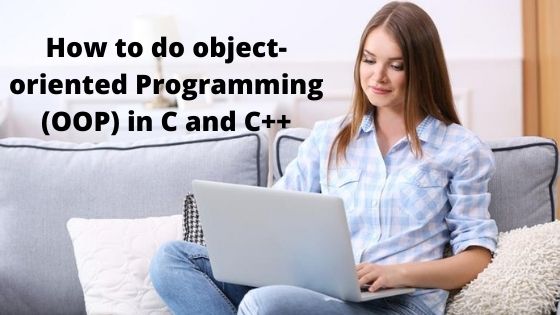OOP is a process in which complicated things are taken care of by splitting them into smaller structures that are used. Programs are written in compiled programming before OOP (normally referred to as Object-oriented programming). There was just a long series of instructions before, but then Object-oriented programming is all about creating objects that can communicate with each other, making it easier to build OOP programs since we can understand the link between them and that is why we need to use C and C++ OOP.
To support Object-Oriented programming concepts, languages like C and C++, have been developed. Nevertheless, did you know that to use the Object-Oriented programming style and get benefits from OOP, you do not have to use an Object-Oriented programming language? If you never knew that you were slim then.
We will discuss in this article how we can introduce some of the techniques of OOP to C and C++, a language without Object-Oriented programming support built in. So, now you have an idea about in C and c++ homework help there is no Object-Oriented programming support in C and C++ and you have to use certain techniques to get that help and we are providing this article to share some approaches with you.
Object-Oriented Programming(OOP)
We compose programs utilizing classes and objects in OOP using excerpts of OOPs, such as abstraction, inheritance, encapsulation, and polymorphism. As the name suggests, OOP uses objects in the programming process. In programming, OOP expects to execute real elements such as inheritance, hiding, polymorphism, and so on. Object-Oriented programming’s key point is to connect the data and the functions that run on them with the intention that, apart from that job, no other part of the code can get to this information.
You need to understand some things to learn certain techniques to use OOP in c and c++, and you can absolutely learn all about object-oriented programming in c programming assignment help and C++.
So, the methods to do that are as follows:
Object and classes
A class appears like a diagram of individuals and specific contributions of data and an entity that we would claim is an example of the class. For example, think we have a car class that has persons with data (factors such as velocity, mass, expense, and functions such as gearChange(), slowDown(), brake(), and etc.
Currently, suppose that we make an entity of this class called Honda Civic that uses and offers its own characteristics to these persons and functions of info. In addition, since we have to use the class, we will render the same number of objects.
Abstraction
In this case, abstraction is a way of disguising unneeded information from the developer or informing the customer. For eg, when you sent an SMS, clearly type the address, pick the contact and deliver you a message directly to another person or smartphone, the mobile indicates you that the message is received, although it is not important to you, what actually happens out of sight when you press send is concealed from you. So, that’s what Abstraction is. The user is named Abstraction to mask the meaningless data front.
Encapsulation
Encapsulation is a way of centralizing data and functions like a shell within a solitary framework. This is to prohibit people from obtaining private data outside the class. We make all class data persons private and create transparent functions that are the public functions to achieve encapsulation, and by using them we can get the attributes of these data persons or set the reward for these data participants. So, in plain language, as we bundle up our data and knowledge in a device, we may tell that the encapsulation is. The unit is identical to a capsule, named Encapsulation.
Inheritance
Inheritance is a function of Object-Oriented programming in which all the attributes of the parent class are inherited by an entity of the child class. A class’s right to acquire properties and attributes from some other class is called inheritance. The child class is the class that gets the properties, and the class from which the properties are obtained is considered the parent class. One of the most important highlights of OOP is inheritance.
Polymorphism
Cases of Polymorphism are feature overloading and operator over-burdening. It is referred to as polymorphism where a function or the operators are encumbered or overloaded at that time. Polymorphism is a characteristic where, in an alternative case, an entity distinctly holds on. We may have more than one function of a similar concept in the Overloading function; however, different numbers, forms, or groupings of arguments or any form of objections are needed.
The term polymorphism suggests that there are multiple structures. We may define Polymorphism in simple terms as the potential of a message to be seen in more than one structure.
We have provided all the necessary information on how to do object-oriented programming (OOP) in C and C++ in case if we forgot something please let us know in the comment section.
